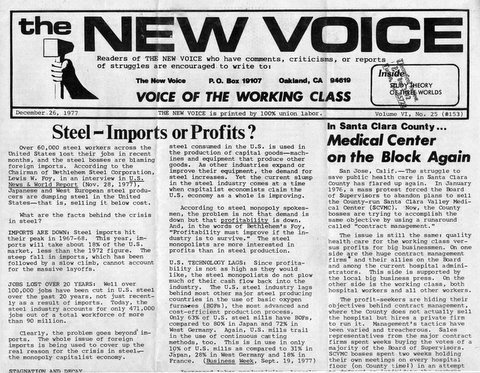
First Published: The New Voice, Vol. 6, No. 25, December 26, 1977.
Transcription, Editing and Markup: Paul Saba
Copyright: This work is in the Public Domain under the Creative Commons Common Deed. You can freely copy, distribute and display this work; as well as make derivative and commercial works. Please credit the Encyclopedia of Anti-Revisionism On-Line as your source, include the url to this work, and note any of the transcribers, editors & proofreaders above.
We urge all readers of The New Voice to study the article, “Chairman Mao’s Theory of the Differentiation of the Three Worlds Is a Major Contribution to Marxism-Leninism.”
This article by the editors of the Peking People’s Daily was published in Peking Review No. 45, Nov. 4, 1977. The New Voice will mail a copy to you.
The 30-page article recalls the Leninist theory of imperialism and world strategy, defines the three worlds, analyzes contradictions in the world today, and cites a great number of specific facts that support the three-worlds theory. The article deals with the distortions of Mao Tsetung’s policy made by sham Marxist gossipers in the United States.
Mao Tsetung put forward the theory of three worlds. He said, “In my view, the United States and the Soviet Union form the first world. Japan, Europe and Canada, the middle section, belong to the second world.” “The third world has a huge population. With the exception of Japan, Asia belongs to the third world. The whole of Africa be-, longs to the third world, and Latin America, too.” (Chairman Mao’s talk with a third world leader, February 1974)
The first world, the two superpowers, are the biggest imperialists in the world today. Their economic strength far outweighs the other, capitalist countries; together they account for 40% of the world’s gross national product total. The contradiction between the two superpowers is sharpening to the point of another world war. The United States has the biggest empire, but the Soviet Union (a monopoly capitalist country that has betrayed the October Revolution) is driven to re-divide empires forcibly in proportion to its own immense weight among capitalist countries.
The third world makes up the vast majority of the world’s population, and its political awakening has made it a powerful force behind national liberation wars, economic struggles against the multinational corporations and political exposure of the two superpowers’ crimes against peace and humanity.
The second world is in contradiction with the two superpowers because of the operation of the law of uneven development among capitalist countries. The people of these countries are caught in the threat of war as the Soviet Union seeks to carve up the world and put down the U.S. imperialists.
The article sets forth the world proletarian strategy of concentrating the international united front against the two superpowers, delaying world war through struggle and approaching revolution along this path.
It is impossible to go into the theory of the three worlds in full in this article. The People’s Daily editorial must be read. The theory was put forward by Mao Tsetung and is a policy of the Communist Party of China, not only of one or another deputy leader of the Party. Comrade Mao was following the Marxist method practiced by Lenin, who classified the world into oppressor nations and oppressed nations. It is not only useless but also anti-revolutionary to confine oneself to formulas like “one world – one class struggle” in a world with workers, peasants, national bourgeois, restive clients of imperialism and imperialists torn by contention.
The theory of three worlds reflects class contradictions. Furthermore, it is advanced by no one as a complete class analysis; it must be combined with a class analysis of each country. This is a task that can be performed only by the revolutionaries of the country. The Marxist-Leninists of each country must make themselves responsible for leading the revolution there. The three-worlds analysis of the international situation is an aid to revolutionary work, not a replacement for it.